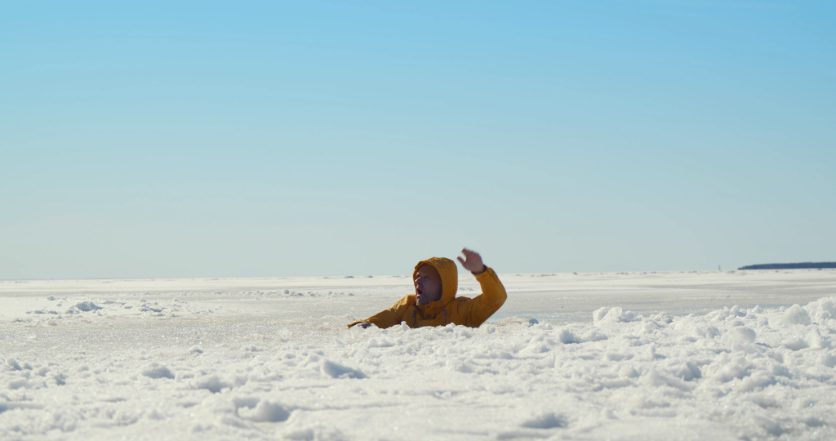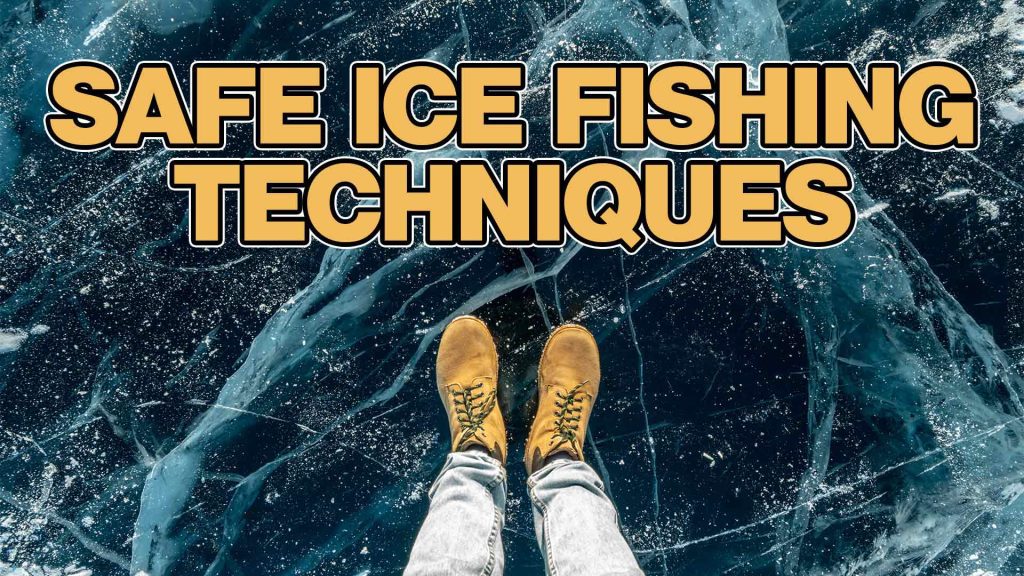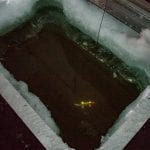Safe Ice Fishing Techniques
Safe ice fishing. Do these words even go together? Ice fishermen know there is no such thing as 100% safe ice. It’s an impossibility because of the natural variation in how ice forms, melts, and refreezes. Still, there are definitive steps that anglers can take to put the odds in their favor and stay safer while out on frozen lakes.
Like the mountaineer analyzing snow slabs when determining avalanche risks, an ice angler can learn to read the ice. Bettering yourself at this skill and utilizing certain tools and techniques will greatly help with ice fishing safety.
Ice Thickness and Color


When it comes to good ice conditions, its appearance is important. You can tell a lot by the color of the ice. As a rule of thumb, clear blue ice is new ice, which is safe ice.
White ice or ice that is opaque, light grey, or mottled white and gray is not safe to be on. This is true regardless of the area or how cold the air temperature is. These colors are indicative of old ice, ice that is melting or is otherwise porous and weak.


Ice that is black or clear blue in color is the highest density and, therefore, the strongest ice to be on. Just make sure the thickness is at least 4 inches; otherwise, the color doesn’t matter – it isn’t safe.
So, how do you know if it is safe? Assuming the area you plan on fishing is covered in new clear solid ice, here are ice thickness guidelines from the Minnesota Department of Natural Resources (DNR):
2” or Less – Stay off
4” Ice fishing or other activities on foot
5” – Snowmobile or ATV
8” to 12” Small pickup
12”-15” – Medium pickup
Ice is often weaker at bends, streams, rivers, bridges, culverts, and areas where partially submerged items are located. So, try to steer clear of these danger zones. In general, smaller bodies of water where there isn’t running water or currents are the safest to recreate on.
Areas where snow has accumulated on the ice, are also not considered safe. There are a few reasons for that. First, snow creates an insulating effect, not allowing the ice underneath to freeze as hard. Second, snow increases the amount of weight which means there is less capacity available for your fishing gear, skid house or snowmobile. Lastly, snow can hide cracks, weak ice, or even open water.
Ice Travel
When traveling on ice, make sure to check ice often with an auger, spud bar, or ice chisel. You can use a chisel or spud bar to test the thickness and character of the ice as you walk. Just make sure to test the ice in front of you. That way, you’ll know if it is thin before you step on it.
It’s also a good idea to invest in a pair of crampons or cleats for walking on the ice. You can affix these to your boots to keep you from slipping.


As you “spud’ along the ice, use an ice auger to create test holes to get a better observation. Keep alternating between punching the ice with the spud bar and making test holes with the auger as you make your way out on a frozen body of water. Cut holes every 300 feet or less if the situation warrants it.
Alternately, you can just use the auger to cut holes as you go.
As mentioned, ice should be a minimum of 5 inches if traveling by ATV or snowmobile. Once you are set up and have determined a safe path, you can proceed to ride to your shanty or fishing location.
Avoid overrunning your headlights if traveling by snowmobile or ATV in low light. Travel at a rate of speed that will allow you to stay behind the beams. It is very easy to become disoriented in the dark and end up in an area of the lake you didn’t intend. Even worse, you could break through the ice. Always maintain control when using motorized travel over ice and be wary during the early and late parts of the season.


Safety Gear and Other Considerations for Safe Ice Fishing
Wear a Personal Flotation Device (PFD)
Whether it’s a lifejacket under your cold-weather fishing clothes or a flotation suit, make sure you are wearing a PFD that will keep you afloat. Breaking through thin ice is a very real possibility when ice fishing or preparing your site.
A PFD will keep you upright in the water long enough to drag yourself out. It will also help reduce the effects of cold-water shock and hypothermia.
Invest in Ice Picks and Wear Them
You wear these simple little devices around your neck. If you break through the ice, your PFD will keep you from going underwater. The ice picks will assist you in crawling out of the hole by giving you leverage on the slippery ice. Holding one in each hand, you’ll stab them into the ice as you crawl and work your way out.
Waterproof Container
Consider a waterproof container that will have a stash of items you need to keep dry. You can throw in items such as an emergency blanket, cell phone, power charging bank, hand warmers, matches, and more.
Don’t Underestimate the Importance of a Throw Rope
A throw rope can be used to pull an ice angler to safety. It can also be used to anchor someone while they work the ice sheet with the auger and spud bar to test the ice.
Dress Appropriately for Extreme Cold Temps
Make sure to wear plenty of layers. Nice days can be deceptively warm or cold. So, you having layers enables you to shed and add as needed.
Partner Up
There’s safety in numbers! Consider bringing your spouse or buddy along. A partner can provide an extra set of hands, eyes, and general support.
Let Someone Know Before You Go
Like any other outdoor activity that can be unpredictable, let people know where you’ll be fishing. Pertinent information like the name of the lake, location, and who you’re going with will be helpful. Also, provide a time you plan to be back. If plans change, let them know of the change, so they don’t call the calvary because you decided to stay longer!


Ice Fishing Houses
Ice fishing houses offer the ultimate in ice fishing comfort. They provide privacy and keep the elements off when the arctic temps get really bad. You can even add a heater if they have a composite floor like Ambush’s premium ice fishing skid houses and dark houses. You’ll stay toasty while fishing without worrying about melting the ice under you.
Ice fishing skid houses like the Slayer Skid house are super-durable with a welded chassis and seamless Durabond panel construction that keeps water out. With several floor plans available; you can choose the hole configuration that makes the most sense to you.
Fishing shanties should have lights or reflectors to provide visibility and keep snowmobilers from crashing into them. Ambush provides porch lights on all skid houses for extra visibility. Anything that keeps snowmachines or ATVs from running into your ice fishing house is good!
Safety while ice fishing is priority number one. Put the odds in your favor, follow these tried-and-true tips, and keep yourself safe this winter!




